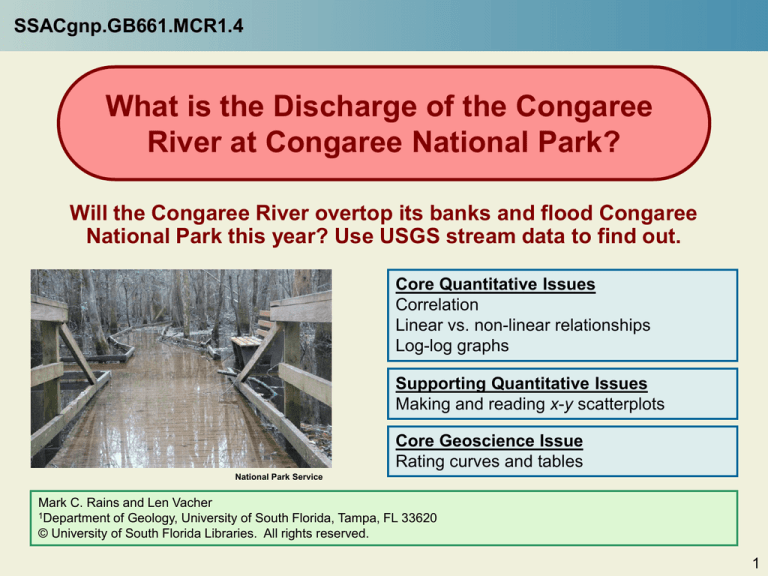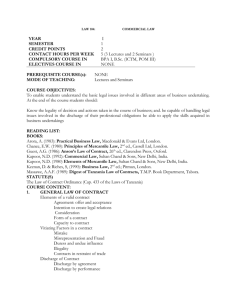
SSACgnp.GB661.MCR1.4
What is the Discharge of the Congaree
River at Congaree National Park?
Will the Congaree River overtop its banks and flood Congaree
National Park this year? Use USGS stream data to find out.
Core Quantitative Issues
Correlation
Linear vs. non-linear relationships
Log-log graphs
Supporting Quantitative Issues
Making and reading x-y scatterplots
Core Geoscience Issue
Rating curves and tables
National Park Service
Mark C. Rains and Len Vacher
1Department of Geology, University of South Florida, Tampa, FL 33620
© University of South Florida Libraries. All rights reserved.
1
Getting started
After completing this module you should be
able to:
• Construct a rating curve and table to convert
measurements
Congaree National Park
• Relate discharge on the Congaree River to
climatic, geologic, and land-use conditions
upstream and outside the park
• Understand how the discharge on the Congaree
River (especially flood flows) are essential to the
health of the floodplain-forest ecosystem
You should also know
where Congaree
National Park is
South
Carolina
2
The setting – Congaree National Park
Congaree National Park is one of the last-, largest, and best examples of old-growth
bottomland forest in North America. This forest has tremendous biodiversity and is home to
many state- and national-champion-sized trees. The Park is a federally designated Wilderness
Area, an International Biosphere Reserve, and a globally important bird habitat. This
ecosystem is part of a complex, post-late Pleistocene riverine landscape. Geologic and
geomorphic mapping has identified numerous landscape features including alluvial fans,
terraces and scarps, creek channels, backwater sloughs, ox-bow lakes, groundwater
rimswamps, ice-age river deposits, ice-age sand dunes, and more.
All photographs National Park Service
3
Floods are Natural and Important!
The floodplain-forest ecosystem at the Park depends on periodic flooding from Cedar Creek
and the Congaree River. Floods sculpt the landscape through sediment erosion, transport, and
deposition. During floods, nutrient-rich sediments are deposited on the floodplain, where they
promote primary productivity (i.e., plant growth), through which CO2 is transformed into organic
carbon compounds by photosynthesis. This organic carbon forms the base of the floodplainforest food web. The plants also have feedbacks on floodplain soils and geomorphology.
Fallen leaves and coarse woody debris form deep organic deposits, while plant roots and
decaying organic deposits increase the rate of weathering in mineral soils. Trees and coarse
woody debris redirect floodplain flows, increasing erosion in some locations and deposition in
other locations and creating complex microtopographic relief. The resulting floodplain
landscape is a complex habitat that supports a diverse assemblage of fish, amphibians,
reptiles, birds, and mammals.
All photographs National Park Service
4
The Problem
Park managers need to know when floods will occur to help them monitor forest health,
address visitor safety concerns, and plan infrastructure maintenance.
River stage and discharge vary over the course of time. River stage is the height of the water
at a particular location in the river; river discharge is the volume of water passing a particular
location along the river per unit time. A flood is simply a period of time when the water flows
out of the channel and onto the adjacent floodplain.
Researchers have determined relationships between discharge on the Congaree River at
Columbia, SC, upstream of the Park and the spatial extent of flooding on the Congaree River
floodplain in the Park (Patterson et al. 1985). For example, at 19,900 cubic feet per second
(cfs), water flows into low spots on the floodplain; at 34,300 cfs, most of the floodplain is
inundated; and at 76,600 cfs, the entire floodplain is inundated. For this knowledge to be
useful, Park managers need to know the discharge on the Congaree River at Columbia, SC, on
a routine basis, sometimes in real time.
Return to Slide 10
Your task will be to develop a rating curve and table so that stage, which is easily measured,
can be used to calculate discharge, which is hard to measure in the field. A rating curve and
table are an x-y graph and accompanying table made from stage and discharge measurements
made at the same time.
Patterson, G.G., G.K. Speiran, and B.H. Whetstone. 1985. Hydrology and its effects on distribution on vegetation in Congaree Swamp
National Monument, South Carolina. U.S. Geological Survey Water-Resources Investigations Report 85-4256.
5
Discharge Measurement and Estimation
It is difficult and time consuming to measure discharge. At first glance, it seems simple,
because the underlying equation used is so simple. Discharge is calculated using a continuity
equation based on the conservation of mass; specifically,
Q Au
Return to Slide 8
where Q is discharge, A is the cross-sectional area through which the water is flowing, and u is
the mean downstream velocity of the water flowing through this cross-sectional area. The
cross-sectional area is
A wh
where A is the cross-sectional area through which the water is flowing, w is the wetted width of
the water, and h is the mean depth of the water. In practice, this is more complicated than it
might seem (Endnote 1). However, one can easily imagine that it might be particularly
complicated in a wide, deep river with an irregular bottom, especially in real time, and more
especially in real time during a flood.
Wouldn’t it be better if there were a way to quickly estimate rather than painstakingly measure
discharge? It turns out there is, and our continuity equation shows us how. Before we do so,
let’s get the data that we’ll need.
6
The Data
Discharge for the Congaree River at Columbia, SC, is measured just upstream of the Park on a
stream gage. Data from this gage, which is operated by the U.S. Geological Survey, are
updated to the Internet by satellite link; you can check the discharge on the Congaree River at
Columbia, SC, any time.
http://wvwgc.wvca.us/images/stream_gage.gif
Note that discharge in the river is not directly measured.
Rather, stage is measured in a stilling well and converted to
discharge using a rating curve and table. The channel and
stilling well are connected by way of pipes. As stage rises and
falls in the channel, water levels correspondingly rise and fall
in the stilling well. Stage is recorded as a height above an
arbitrary datum. This, of course, requires that a rating curve
and table be available for this gage. Rating curves and tables
are constructed from simultaneous measurements of stage
and discharge which are made repeatedly over the course of
many years. Field data for these measurements are available
for this gage.
Here are the field data that we will use: 292 measurements of stage and
discharge made August 1940-April 2012. Click on the Excel worksheet to the
left and save immediately to your computer. Complete the spreadsheets at
each of the tabs starting with “Slides 9 & 10.” Yellow cells contain given
values, and orange cells contain formulas. The spreadsheet at the “EOM
Answers” tab is for your answers to the end-of-module questions.
7
Correlation and Dependence
The full field data have a lot of information, including all of the
information needed to calculate discharge. For simplicity, we
have cut the data down to date, stage (H), and discharge (Q)
and placed them on the worksheet titled “Stage-Discharge
Data.”
Go back and review the equation for discharge on Slide 6. What happens to discharge if width,
mean depth, cross-sectional area, or mean velocity increase? Obviously, in all cases,
discharge increases. Now, note that stage and mean depth are both measures of height, with
the only difference being the reference data; the reference datum for stage is an arbitrary
height, and the reference datum for mean depth is the mean bottom height. Therefore, we also
can say that discharge increases as stage increases.
We can say, therefore, that stage and discharge are correlated. Correlation is a general term
indicating that a change in one of the variables statistically “predicts” a change in the other
variable – i.e., the variation of the two variables are not independent of each other. In the case
of stage and discharge, the correlation is positive, meaning that the two increase and
decrease together. Negative (or inverse) correlation is also possible; in such cases, one
variable increases when the other variable decreases.
Positive correlation
Negative correlation
8
Exploring the Correlation
Let’s explore the correlation between stage and discharge by making an x-y scatterplot, with
discharge on the x-axis and stage on the y-axis. Add vertical and horizontal grid lines. Clearly
label your axes. Include the units. Your figure should look like ours.
The graph shows that stage and discharge
are, indeed, positively correlated. However,
the rate at which they vary relative to each
other changes with magnitude. This is
expressed by the slope of the relationship.
The slope is larger at low-magnitude
discharges than at high-magnitude
discharges. Stated more simply, stage
changes rapidly as discharge varies over
low-magnitude discharges and slowly as
discharge varies over high-magnitude
discharges.
Now automatically fit a best-fit straight line to the data. Do so by right-clicking on the data
points, selecting “Add Trendline…” from the drop-down menu, and selecting “Linear” from the
“Trendline Options.”
How well does this line fit the data points at extremely low discharges? At moderate
discharges? At extremely high discharges?
Return to Slide 16
9
Exploring the Nonlinear Relationship
You should have found that the best-fit straight line poorly fits the shape of the stage-discharge
relationship. This is because the stage-discharge relationship is nonlinear. If it were a linear
relationship, then the rate of change between stage and discharge would be roughly the same
throughout the range of the relationship, i.e., it could be expressed as a single straight line
passing through or near all of the measurements. However, as we saw before, stage vs.
discharge is a nonlinear relationship, because the slope of the curve varies (decreases)
through the range of the relationship. It cannot be expressed as a single straight line passing
through or near all of the measurements.
Before we explore nonlinearity further, let’s further explore the correlation between stage and
discharge using our current x-y scatterplot. Make two straight lines, making one pass more or
less through the mass of low-magnitude discharges and the other pass more or less through
the mass of high-magnitude discharges. Do not try to automatically fit these lines. Instead, do
this by hand by using the “Line” tool in Excel. Make sure that your two lines intersect
somewhere within the cloud of data points. (Endnote 2)
The intersection of the two lines indicates a threshold, where the rate of change of stage
relative to discharge changes rather abruptly. Below this threshold, relatively small changes in
discharge predict relatively large changes in stage; above this threshold, relatively large
changes in discharge predict relatively small changes in stage.
At what approximate discharge does this threshold occur? Why should we expect such a
threshold? Hint: Recall that researchers have determined relationships between discharge at
this gage and flooding nearby (Slide 5).
Return to Slide 16
10
Logarithmic-Scale Axes
The general shape of your stage-discharge curve is the general shape of curves expressing
many hydrologic and/or geomorphic relationships. These relationships belong to an important
class of functions called power functions. Power functions, like linear functions (straight
lines), exponential functions, trigonometric functions, and the bell-shaped curve are crucial
modeling functions in the work of science. Power functions have the extremely useful property
of plotting as straight lines when the x- and y-axes of the graph are transformed from an
arithmetic scale (what they are now, in the previous slide) to a logarithmic scale (what they will
be, in the next slides). Because power functions are so common, and because they are
transformed to straight lines so easily by changing the scale of the axes, hydrologists and
fluvial geomorphologists often prefer to work with log-log plots of their data. (Endnote 3)
Transforming graphs from arithmetic-scale axes to log-log plots has another benefit for
phenomena such as stream flow. It brings the typically sparse high-magnitude events closer to
the cloud of points representing the many low-magnitude events. Consider the x-y scatterplots
below. The data in both x-y scatterplots are the same, but the high-magnitude values are just a
few major units away from low- to moderate-magnitude values on the x-y scatterplot with loglog axes.
Arithmetic-scale axes
Logarithmic-scale axes
11
Exploring the Correlation Again
Now, let’s continue exploring the correlation between stage and discharge. Make a copy of your
previous x-y scatterplot by right-clicking on the worksheet tab, selecting “Move or Copy…” from the
menu, and selecting the “Create a copy” radio button. Transform each axis by right-clicking on each
axis, selecting “Format Axis…” from the menu, and selecting the “Logarithmic scale” radio button.
Your figure should look like ours. Hint: You must also change the minimum on the x-axis to 100.
The only difference between your previous xy scatterplot and this x-y scatterplot is the
axes, with arithmetic-scale axes on your
previous x-y scatterplot and logarithmicscale axes on this x-y scatterplot. Use the
vertical and horizontal grid lines that you
added to each x-y scatterplot to see
precisely how changing the axis scales has
changed both the shape of the curve and
how you interpret the information presented
by the curve.
Now automatically fit a best-fit straight line to the data. Do so by right-clicking on the data
points, selecting “Add Trendline…” from the drop-down menu, and selecting “Power” from the
“Trendline Options.”
Compare the trendlines created from Slide 10 and this slide. Which trendline has the best fit to
Return to Slide 16
the data?
12
Building the Rating Curve and Table, 1
The straight line on a log-log plot identifies the variation of stage vs. discharge as a power law
relationship. In the same way, a straight line on a plot with the y-axis on a log scale and the xaxis on an arithmetic scale identifies the plotted variation as an exponential (so called “loglinear”) relationship. In either case, transforming both (or one of the) the axes makes it is much
easier to visualize and analyze nonlinear data.
Your x-y scatterplot with the log-log axes is your rating curve. Now let’s use it to develop your
rating table.
Click the Tab labeled Slide 13. This is where you will create your
Rating Curve. You will see two columns, one with specified stages (H),
and the other with empty cells for the corresponding discharges (Q).
For each of the specified stages, find the corresponding discharge. As you do so, use the
straight line fitted through the actual measurements instead of the actual measurements
themselves. Specifically, find the specified stage, follow the grid line at that stage to the
straight line fitted through the actual measurements, and draw a straight line down to the
corresponding discharge.
When you try to do this, you will find that you have to interpolate between known values on the
x-axis. For example, at a stage of 2 ft, the corresponding discharge is about half-way between
1,000 cfs and 2,000 cfs. How do you interpolate values on a log scale?
13
Building the Rating Curve and Table, 2
What value is a discharge half-way between two known discharges? Because you are more
accustomed to working with arithmetic axes, your first guess might be the midpoint of the two
values. However, that guess would be incorrect. You are now working with a logarithmic axis,
and half-way values are not equally spaced.
What discharge is half-way between 100 cfs and 200 cfs on a log scale? If you were to guess
that discharge to be 150 cfs, and plot the three values (100, 150, and 200) on the log scale, you
would find more separation between 100 and 150, than between 150 and 200 (try it!). On the
other hand, if you were to plot the three values (100, 141, and 200) on the log scale you will
find the three points equally spaced. Why? The reason is that log(100) = 1.00, log(141) =
1.15, and log(200) = 1.30, and 1.15 is half-way between 1.00 and 1.30. So, converting an
arithmetic scale to a log scale is the same as taking the log of each of the values and plotting
the log-transformed data on an arithmetic scale. Therefore, all we need to do to find
intermediate values is to calculate the logarithms of the discharges, linearly interpolate between
the two logarithms, and convert the intermediate, interpolated logarithm back to its “unlogged”
value. The logarithm of 100 is 2.00, and the logarithm of 200 is 2.30, so the half-way logarithm
is 2.15. What value has a logarithm of 2.15? The answer is 102.15, which is 141. (Raising 10
to the power of log x produces x by the definition of logarithm.) Therefore, the discharge that is
half-way between 100 or (102) cfs and 200 (or 102.30) cfs on a log scale axis is 141 (102.15) cfs.
With this last lesson in mind, finish developing your rating table. Note that you will be
interpolating, at times, on both the x- and y-axes.
14
Caveat on Correlation and Causation
One commonly hears the warning, stated in many ways, but most commonly as “correlation
does not imply causation”. This statement is basically true, but it is not the whole story.
A well-known example of misinterpreting correlation is in the history of epidemiological studies
of post-menopausal women. In early studies, it was found that women who underwent
hormone-replacement therapy also had a lower incidence of coronary heart disease, a
correlation that led some researchers to claim that hormone-replacement therapy lowered the
risk of coronary heart disease. However, further study showed that women who underwent
hormone-replacement therapy also tended to come from socioeconomic classes with betterthan-average diet and exercise regimens, factors that have long been known to lower the risk
of coronary heart disease. In later studies, in which socioeconomic class was controlled, it was
found that women who underwent hormone-replacement therapy actually had a slightly higher
incidence of coronary heart disease. This example illustrates a common reason why causation
does not follow necessarily from correlation: the presence of a confounding variable.
On the other hand, our stage-discharge relationship is an excellent example of a case where
correlated variables are causally related. It is absolutely true that changes in discharge cause
changes in stage. If there is more water, then stage increases; if there is less water, then stage
decreases. This would have to be the case, unless something were done to change the crosssectional geometry of the channel or the velocity of the water passing through the crosssectional area, in which case our stage-discharge relationship would no longer apply.
15
End-of-Module Assignments
1.
Turn in your Excel workbook to show your figures and tables.
2.
What are the costs and benefits of floods?
3.
Check the current discharge at Congaree River at Columbia, SC. What is the discharge? (Note the date
and time of your observation.) Is the Park flooding?
4.
Define all of the bold-type terms in the module in your own words.
5.
Answer the questions posed in the bottom box on Slide 9, the bottom box on Slide 10, and the bottom
box on Slide 12.
6.
Using only your rating curve and table, determine the discharge when stage is 1 ft and 40 ft. Can you
really know? Regardless, what would Park managers know with regards to flooding in the Park when
stage is 1 ft or 40 ft?
7.
Present two cases of correlation not otherwise presented in this module, one in which two variables are
correlated but in which there is no causation, and one in which two variables are correlated and in which
there is causation. These can be either real or hypothetical.
16
Endnotes, 1
1. Discharge measurement would be relatively easy if cross-sections were perfectly
rectangular and beds and banks were completely lacking in friction. In such a case, the mean
depth would simply be the depth and the mean velocity would simply be the velocity, so
measurements of both could be made near the banks. However, cross- sections are irregular
and beds and banks have a great deal of friction due to the viscosity of water and physical
obstructions to flow (e.g., topographic relief, large sediment clasts, vegetation). Therefore,
discharge is actually measured by subdividing the cross-section into smaller subsections,
calculating discharge through each subsection, then adding up all of the subsections into a total
discharge for the cross-section. In smaller streams, this is done by wading; in larger streams
this is done from boats, bridges, or suspended cable cars. Return to Slide 6.
U.S. Geological Survey
17
Endnotes, 2
2. Much of the study of stage-discharge relationships has been done by hand, even after the
advent and common use of computers. Very late in his life, Dr. Luna Leopold, arguably the
most important surface-water hydrologist and fluvial geomorphologist of the 20th Century, and a
pioneer in the measurement of stage and discharge and the creation of rating curves and
tables, visited one of the lead author’s field sites, a river and floodplain that had recently been
restored. After touring the field site, Dr. Leopold was asked if he could think of any good
exercises that students could do using the stage and discharge field measurements. The
answer was yes, but he began with a passionate statement. “First,” he growled, “No
computers!” Return to Slide 9.
3. We see this same general shape when we plot discharge on the x-axis and width, mean
depth, or velocity on the y-axis, or watershed area on the x-axis and width, mean depth,
velocity, or discharge on the y-axis. These specific relationships are known as hydraulic
geometry relationships. They were first recognized in the late 19th Century by British waterresource engineers working on irrigation canals in colonial India. They were first applied to
natural rivers by Leopold and Maddock (1953), and have since become perhaps the bestknown relationships in all of fluvial geomorphology. One important way in which they are
commonly used is in sizing river channels during river restoration efforts, because the width,
mean depth, and cross-sectional area can all be calculated from the design discharge. Return
to Slide 11.
Leopold, L.B., and T. Maddock, Jr. 1953.The hydraulic geometry of stream channels and some physiographic implications. U.S. Geological Survey
Professional Paper 252.
18








